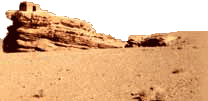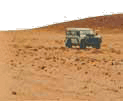|
Click
on an image below to view full size. Images will open in a new window
as a pop-up.
If you experience issues, then you might have to turn off the pop-up blocker
on your computer.
|
 |
 |
 |
 |
| The Red Sea mountains; through the Wadi Yutm to Aqaba. |
The theatre at Petra, cut through ealier Nabatean tombs; it seats around 6,000 people. |
The steps lead to a Nabataean tomb concealed in the folds of the rock. |
Camels in the Hisma desert; worth up to £1,000 each, they roam free, branded to indicate their owners. |
 |
 |
 |
 |
| The Royal Tombs at Petra - the most elaborate examples we have of Nabatean architecture. |
Evening in Wadi Rum; we sleep here on the way to Aqaba, sheltered by the great cliffs. |
Wadi Nimla in the Dead Sea rift; camel caravans stopped here on the ascent to Petra. |
Jebel Ain Ghazal near Rum - figures at bottom left to give a sense of scale. |
 |
 |
 |
 |
| Nabataean cisterns at Jebel Ain Ghazal - the plant rowth shows us where to find them. |
Signpost to the ancient buried city of Humeima - this is as close to tourist information as it gets. |
A wayside grave in the desert - the bedu are buried near known tracks. |
The Wadi Farasa, on the way up to the High Place of Sacrifice in Petra. |
 |
 |
 |
 |
| The Emperor Diocletian sent Chritian slaves to work the copper mines in these hills, at Wadi Feinan. |
We can walk down through these beautiful mountains from Petra to the Wadi Araba, following the ancient caravan route. |
We can't remember the joke, but look at the cistern - Nabataean, but restored and in use by local herders. |
A Bedu grave - the occupant will be buried to face Mecca. |





